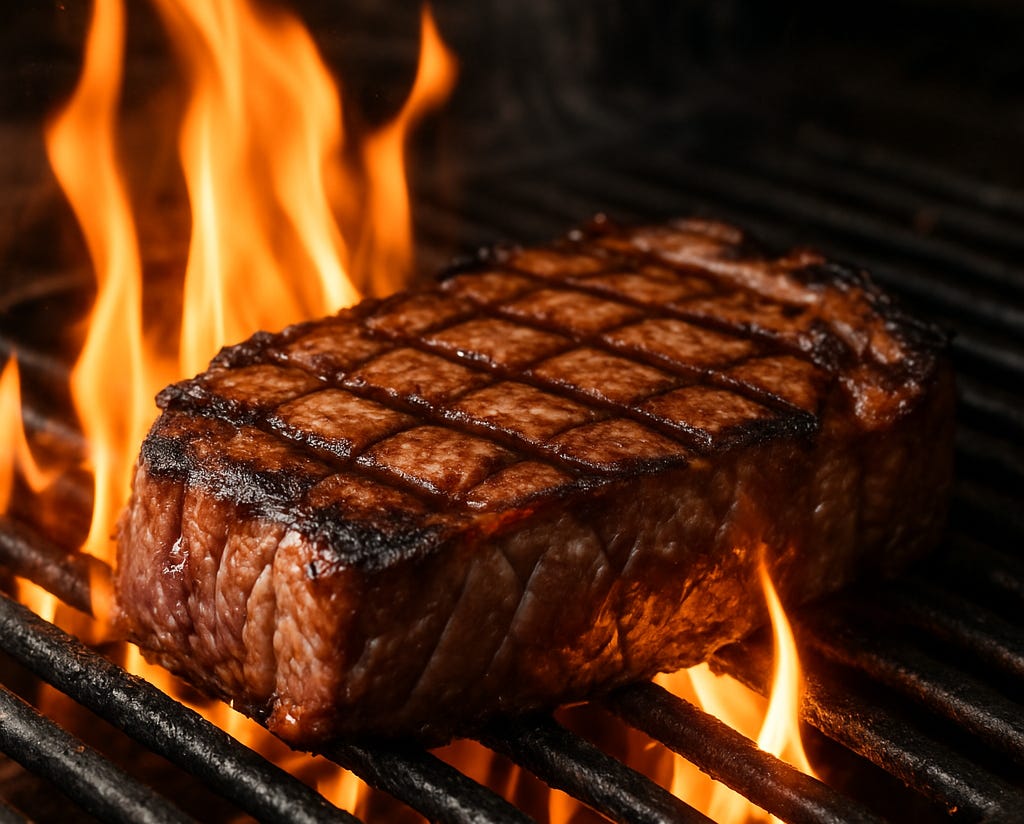Why do seared steaks taste so irresistible? It’s thanks to the Maillard reaction, a chemical dance between amino acids and sugars that occurs when food hits high heat. Named after French chemist Louis-Camille Maillard, it creates complex flavor compounds that define the savory depth of cooked foods.
What Is It?
The Maillard Reaction, indispensable when cooking a great steak like ours, begins around 140°C and intensifies up to 165°C. It produces hundreds of different flavor compounds, depending on the type of protein, sugar, cooking time, and temperature. These compounds then break down into even more nuanced aromas and flavors, creating everything from the nuttiness of brown butter to the crusty edge of a baguette. The rich and savory result is often described by chefs using the Japanese term “umami”, a depth that’s neither sweet, sour, bitter, nor salty but satisfying.
For example, consider a burger. The interior remains relatively bland if it’s simply steamed, but toss that patty onto a hot grill, and the exterior quickly develops a brown, crackly crust. That crust isn’t just texture, it’s a chemical medley of grilled, roasted, and meaty notes, only made possible by the Maillard reaction. The same principle applies to countless other foods: roasted meats, pan-seared scallops, toasted marshmallows, baked cookies, even malted barley in beer production.
Maillard vs. Caramelization
It’s easy to confuse the Maillard reaction with caramelization, but they’re fundamentally different processes. Caramelization involves only sugar and typically begins at higher temperatures (around 170°C). Think of the difference between toasted bread (Maillard) and flan’s burnt-sugar topping (caramelization). Both contribute to browning, but the Maillard reaction is more diverse in flavor and more central to savory cooking.
In Modern Cuisine
Understanding the Maillard reaction isn’t just for chemists, it’s crucial knowledge for serious chefs, food scientists, and even coffee roasters and brewers. Modernist cuisine has elevated this awareness further, using tools like Sous Vide circulators and blowtorches to manipulate browning in highly controlled environments.
For example, a sous vide steak cooked at 54°C won’t undergo the Maillard reaction during its water bath, but a quick sear in a hot pan or blast with a torch afterward delivers the flavorful crust. This combination ensures perfect doneness with the added depth of Maillard browning.
Coffee and chocolate industries rely heavily on this reaction during roasting, tuning times and temperatures like a composer shaping a score. A slightly shorter roast can mute desirable compounds; too long, and bitterness or burnt flavors dominate.
When It Goes Too Far
Like many good things in cooking, things can go wrong. Extended browning or excessive heat can turn complex flavor into char and bitterness. And it’s not just about taste—overcooking can also produce potentially harmful compounds like acrylamide, particularly in starchy foods like French fries or potato chips. Moderation and control are key, so is understanding when to coax the reaction to peak performance and when to pull back.
It’s not just about browning—it’s about balance.
Image Credit: https://churrascophuket.com
_ _ _
© CHURRASCO PHUKET STEAKHOUSE / ALL RIGHTS RESERVED
Reprinting, reposting & sharing allowed, in exchange for a backlink and credits
Churrasco Phuket Steakhouse serves affordable Wagyu and Black Angus steaks and burgers. We are open daily from 12noon to 11pm at Jungceylon Shopping Center in Patong / Phuket.
We are family-friendly and offer free parking and Wi-Fi for guests. See our menus, reserve your table, find our location, and check all guest reviews here:
https://ChurrascoPhuket.com/
#Churrascophuket #jungceylon #phuketsteakhouse #affordablewagyu #wagyu

